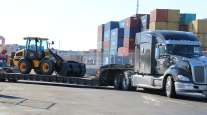Orchestrating the Supply Chain

An increasingly constrained freight market is ratcheting up the pressure on shippers to improve the performance of their supply chains and make better use of the limited hauling capacity of their own private fleets and for-hire carriers.
To further streamline the movement of goods, many companies are adopting various forms of technology to improve shipment tracking and enhance the flow of information.
“We want total supply chain visibility,” said Chris Sultemeier, the former head of supply chain at Walmart Inc. who is working as an industry consultant.
2018 TOP 100 PRIVATE CARRIERS: See the new rankings
LIVEONWEB: Watch "Orchestrating the Supply Chain"
When Hurricane Katrina struck the U.S. Gulf Coast in 2005, Sultemeier said he realized how little he knew about the location of goods that would be needed to help the region recover.

Chris Sultemeier
“That resonated loud with me,” Sultemeier said in an interview with Transport Topics. “And it started the ball rolling.”
Later, as the head of Walmart Transportation, Sultemeier remembers meeting with a vendor to discuss an upgrade of the onboard computers used in the company’s fleet of trucks.
“I remember thinking, this isn’t about hardware. It’s about information and connecting things. We can’t be wrapped around a hardware solution,” he said. “In an age of iPhones and open-source applications, what we need is an agnostic device that connects all the components of the truck and gives us the ability to go in and build any application we want that meets our business needs.”
Such a solution didn’t exist then, and still doesn’t, at least in a complete form, although Sultemeier says he sees it “on the horizon.”
Since retiring from his position at Walmart in 2017, Sultemeier has joined forces with Platform Science, a technology firm that is attempting to provide connectivity among trucks, stores and distribution centers and is headed by Jack Kennedy, a former president of trucking technology supplier Omnitracs.
“Now we have the ability to do it,” Sultemeier said of the effort to create a digital view of the supply chain for shippers. “What is not yet fully defined is do we go down to the product level or caseload level in terms of connectivity. Does Walmart, for instance, want to know where every box of ramen noodles is that sells for 89 cents?”

A walmart employee stocks electric fans. (Timothy Fadek/Bloomberg News)
What’s important, Sultemeier said, is that shippers not be forced to wait for vendors to develop a product that they believe will be in demand in the broader market.
Just tracking cargo on trucks and containers gives most shippers the means to cover 90% to 95% of their supply chains, and that can produce major potential benefits, Sultemeier said.
“Today an overseas shipment runs between 35 and 50 days. If we can reduce that by just one day, we save the cost of carrying that inventory,” he said. “And if we know where stuff is, we can reduce out-of-stock items, which is the Holy Grail for retail.”
With more precise information on the status of shipments and better forecasts of shipping demand, companies have the opportunity to switch to lower-cost modes of transportation.
“If we get better information, the entire supply chain is more efficient,” Sultemeier contends. “Trucks are not sitting and waiting. Drivers are doing more work during their hours-of-service limits.”
Delays at loading docks represent a huge waste of time for drivers and cost shippers billions of dollars in detention fees and higher freight rates, according to Jason Foshaug, a former shipping executive who recently launched a business called VelocityRater.
This company uses data on dwell times to identify sites that have excessive delays in the loading/unloading process and provides benchmarking tools to help both shippers and carriers understand the impact delays are having on their businesses.
“Shippers know how to fix this, they just need to know where to start,” Foshaug said, “but many are simply not aware of the problem or [don’t] understand how this can negatively impact their competitive position in a local market.”
Envisioning the Future of Freight
Readers describe their vision of the future of freight.
Technology will continue to drive developments in trucking, from more fuel-efficient equipment to autonomous vehicles. Creative alternatives to offset the continuing driver shortage will be created. Outsourced logistics will continue to grow as private fleets will become more expensive to own and manage.
— Rob Hooper, CEO, Atlantic Logistics
Trucking is one of several massive global industries that is evolving rapidly because of new technology. I believe that data collection and network synchronization can bring increased efficiency to trucking and dramatically impact the way that trucking companies operate in the global economy.
— Ozan Baran, founder and CEO, QuickLoad
Create the backbone for freight to communicate in real-time environmental conditions, location (indoor and outdoor), security and price through the use of blockchain-connected sensors.
— Orlando Remédios, co-founder and CEO, Sensefinity
Tracking of all equipment so customers can see where the truck is and know the [estimated time of arrival]. Customers — both receivers and shippers — knowing the value of the driver’s time and loading quickly. The future driver will be more of a relay driver to ensure they are home with their family.
— Teresa Oswalt, operations manager
I think it will go to driverless trucks, but the first- and last-mile industry will be the last and the hardest to complete.
— Jackie Mattare

An autonomous TuSimple truck drives on a highway. (TuSimple)
Freight transport would need to fix the problem of rising freight rates with driver shortages.
Freight movement now has a clear and renewed focus on tracking driver behavior and hours of service. The future would see a dominating need to optimize capacity across all types of vehicles.
Better driver management would help allocate the right trip to the most suited driver well-versed with the route and learned in the type of vehicle assigned.
Automated allocation of shipments to vehicles and drivers would speed up transportation, bringing down lead time and downtime.
Machine learning would be used more and more to design faster and safer routes for trips. This would bring down the turnaround time, in turn bringing down the fuel and maintenance costs.
Live tracking of moving resources would make transport companies agile and responsive.
Companies would be able to track driver behavior such as speeding, unnecessary detention, deviation from planned routes, harsh braking, etc., with instant alerts and notifications passed on to the supervising manager or stakeholder.
Real-time traffic pattern analysis would help predict the best route and accurate ETAs for reaching the in-transit hubs and destination locations.
Fast scanning with in-app or connected scanners would help with fast loading and unloading at hubs, reducing the total time spent there while increasing the transparency with error-free documentation and tracking of each unit transported.
All this would help companies better manage the hours of service of each driver to comply with regulatory and service-level agreements. Instances where a driver’s mandatory break time ends up delaying critical orders would be almost nullified as the driver’s time would be well tracked and managed right from a single dashboard giving end-to-end visibility over all moving and on-ground resources.
Such automation of allocation, routing, tracking and compliance would be the primary need for most companies to run their operations sustainably and profitably.
— Faiz Shaikh, brand content head, LogiNext
Motor carriers typically charge $50 to $100 an hour if drivers are detained beyond two hours. Foshaug estimates that $35 billion is paid out each year in detention charges and in higher freight rates.
Delays also reduce capacity for shippers as carriers increasingly avoid going to locations with slow turnarounds.
“Shippers that turn trucks around in one to two hours are not struggling to get capacity,” Foshaug said.
Foshaug said he successfully dealt with the problem of detention in the past by monitoring metrics daily, pre-staging loads where possible and instituting a special bonus pay program for dockworkers. He also used a clock that began ticking when trucks arrived to provide a visual reminder of the time spent loading and unloading.
In addition, shippers can mitigate delays by ramping up their work forces during high-volume peak periods and by staying open later in the day and on weekends.
Foshaug does not recommend using appointment times to manage the flow of trucks.
“It’s not helpful to carriers,” he said. “Appointments should be set by day or even blocks of time during the day, then first come, first serve, but not a specific time.”
When drivers miss an appointment time, they generally go to the back of the line and that leads to major problems for dispatchers in keeping the drivers on schedule for their next pickups.
At Eaton Steel Bar Co. in Taylor, Mich., company officials have taken steps to make their own facilities and those of their customers more welcoming to drivers. The company is building a new truck maintenance facility in Detroit that will offer food and recreational amenities for drivers while they wait for loads. Also, a new racking system has been installed at some of its facilities to speed up loading and unloading of flatbed trailers.
In addition, the company implemented a detention charge of $100 an hour after the first two hours and raised its rates for customers that create the most delays for drivers.
“We see a lot of changes,” said John Lamarand, operations manager for Atlas Trucking & Logistics, a private fleet for Eaton that operates 125 tractors.
For private fleet managers surveyed by Transport Topics, the most important technologies are those that have an impact on safety and efficiency.
Paul Mugerditchian, president of DOT Transportation, said he is looking for “anything related to safety.” Brad Peppers, fleet manager at Shamrock Foods in Phoenix, seconded the motion, saying he wants “anything safety related.”
The Army & Air Force Exchange Service in Dallas recently took delivery of six new tractors with advanced safety features, including automatic braking and blind spot monitoring, which, according to a company spokesman, already proved to be a factor in helping one of its drivers avoid a crash after his vehicle was cut off in traffic.
“We’ve ordered 20 more,” the spokesman said, adding that the company is looking at deploying real-time tracking, telematics and predictive analytics and event recorders in its fleet.
The use of cameras in the cab and driver coaching were priorities for a number of fleets surveyed, including Air Products in Trexlertown, Pa., and Silver Eagle Distributors in San Antonio.
“Right now, it’s driver behavior monitoring, lane departure, collision avoidance,” said Ed Pritchard, senior vice president at Silver Eagle Distributors. “In the future, autonomous technology will be taking over out of necessity.”
David Adney, vice president of transportation for Hobby Lobby in Oklahoma City, cited engine diagnostics and “predicting the next breakdown before it happens” as a key area of interest for his firm.
Several fleets cited electronic logging devices and one fleet, Valley Proteins, listed “dynamic dispatching tools” as an important technology for its business.
A few companies, including McLane Co. and The Sherwin-Williams Co., mentioned autonomous vehicles or electric-powered vehicles.
Several fleets have announced plans to invest in alternative-fuel trucks.
In May, Anheuser-Busch Cos. in St. Louis placed an order for up to 800 hydrogen-electric powered tractors from Nikola Motor Co. That followed an order in December for 40 Tesla battery-electric tractors.
Sysco Corp., the nation’s largest food service distributor, placed orders for 50 Tesla Semis in a move that company officials described as the beginning of a process of incorporating alternative-fuel trucks into its fleet.

A Sysco tractor waits at a loading dock. (TT File Photo)
“This reinforces Sysco’s commitment to corporate social responsibility by reducing the environmental impact of our operations,” said Tom Bene, president and chief operating officer. “We will also benefit from reduced fuel and maintenance costs and drive associate enthusiasm with the introduction of new and unique technology.”
For some, the increased focus on monitoring drivers and shipments is a prelude to the eventual adoption of broad-based data sharing platforms.
Blockchain is one of the technologies that could provide shippers and carriers with a secure network to record data on the movement of goods.
Blockchain is an especially valuable resource for tracking shipments across borders, said Ricardo Costa, chief information officer for Purolator Inc.
The first effects will be seen in the technology and pharmaceutical industries, he said.
“Getting parts and product delivered using blockchain offers all involved parties complete transparency,” Costa explained. “Different factories creating parts for a technology product will be able to trace back any malfunctions or issues using serial numbers and address any problems faster.”
Likewise, blockchain will give food and drugs makers the ability to monitor products from origin to destination, making it easier to identify sources of contamination and eliminate waste.
FedEx Corp., for example, is developing a blockchain application to identify and retrieve unused medications from cancer patients in Memphis, Tenn.
And in Switzerland, the nonprofit Olam Foundation is using blockchain to identify food that is at risk of being thrown away because of spoilage or expiration due to shipping delays.
While blockchain may form the basis for a new collaborative relationship between shippers and carriers, a recent report by KPMG suggests that future supply chains will also need to have the ability to adapt to changing market conditions and new technologies, such as 3D printing, robotics and autonomous vehicles.
“We call this the learning supply chain,” Sam Ganga and Arun Ghosh, principals at KPMG, said in the report. “The fundamental premise is that companies need to change the way they are run by using leading indicators of measurement and performance and managing it as a real-time, event-driven network supplemented by intelligent automation.”

Manufacturing is a business that could be disrupted by 3D printing. (Fast Radius)
One variant of 3D printing even applies to food.
Tyson Foods is investing in companies, such as Memphis Meats, that are replicating animal products in a laboratory. If successful, this process will have implications for companies that transport livestock and meat products.
Manufacturing is another industry that could be disrupted by 3D printing, according to Rick Smith, founder of Fast Radius, a 3D printing company backed by UPS Inc.
Speaking to members of the Truck Trailer Manufacturers Association recently, Smith said manufacturing is ripe for disruption because it is “incredibly inefficient.”
“The entire system has been built on one simple equation, and that is the more things you make, the lower the cost of each. Eventually, you’ll be able to print anything that you can imagine. And costs are not tied to the number of units produced.”
The need for a more responsive supply chain, coupled with capacity constraints and rising freight rates, will force many shippers to adopt technology to streamline operations, including dock scheduling and yard management software, said Dan Clark, president of Kuebix, a firm based in Maynard, Mass., that provides a free multimodal transportation management program.
“Shippers who don’t begin embracing technology will continue to face increasing pressure in the coming months because of the changing supply-chain environment,” Clark said.




